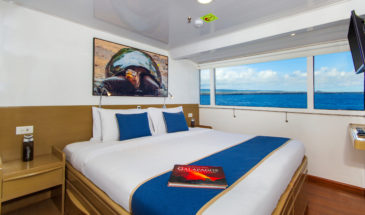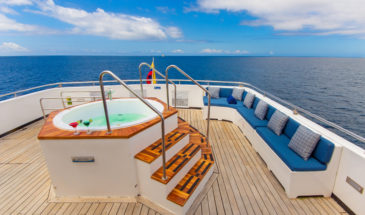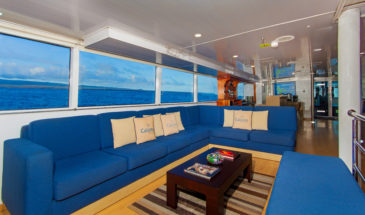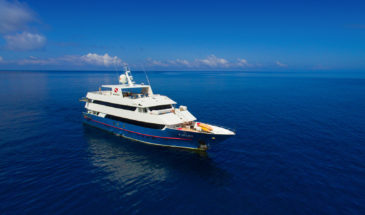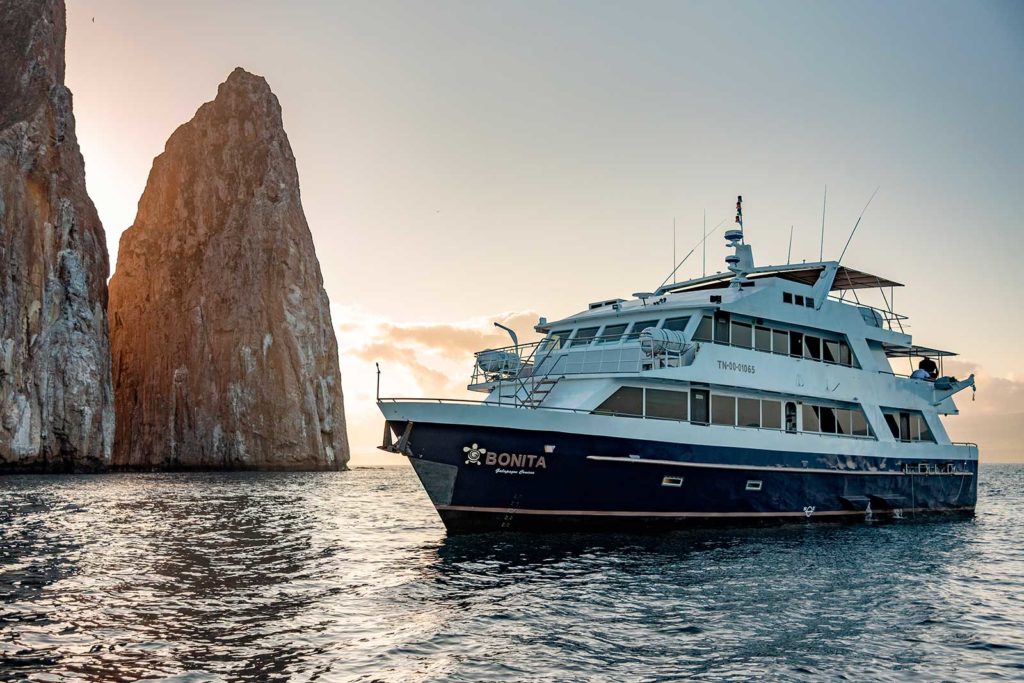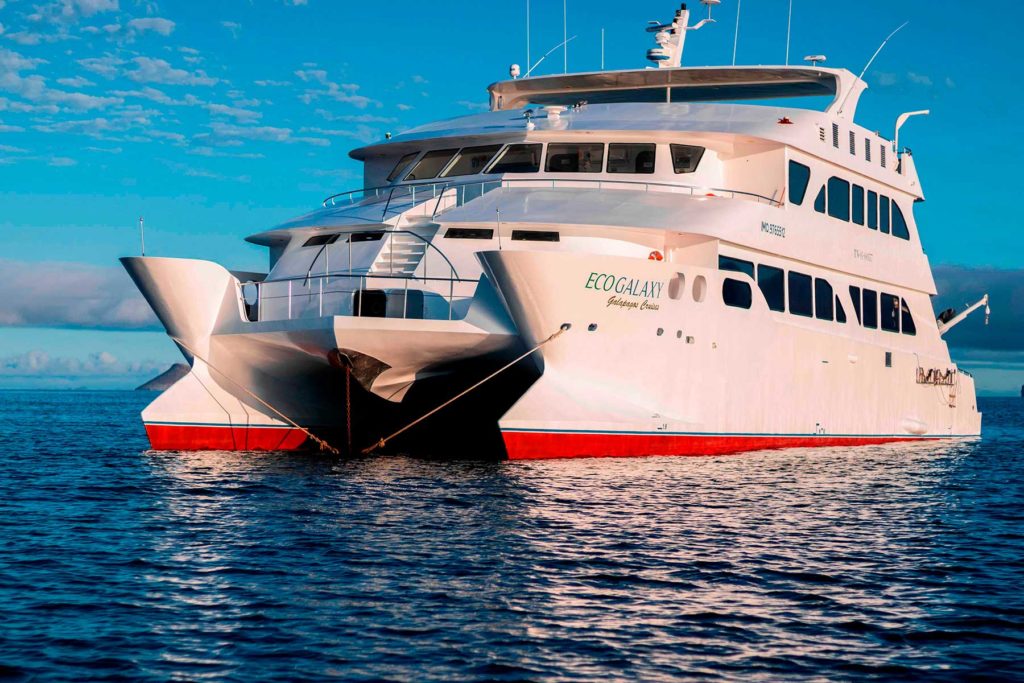- Features
- Rates
- Includes
- Gallery
- Itinerary A - 4 Days
- Itinerary B - 5 Days
- itinerary C - 6 Days
Dimensions
- Length: 115 ft / 35 m
- Beam: 24 ft / 7.3 m
- Cruising speed: 11 knots
- Engines: Cummins NTA855-M @400hp (x2)
- 10 Crew members + 1 Guide
- First Aid, Oxygen and AED
- Life Jackets and Life Rafts
- Nautilus Lifelines, dive alerts
- Radar and sonnar
- VHF Radio. Antenna GPS
- Searchlight and Horn
- Bilge pump alarm
- Fire Alarm System and Extinguishers
- Smoke and temperature detectors
- CO2 reserve (150 Kg)
- Dining room, bar, social área
- Al fresco dining
- Sundeck with Jacuzzi
PRICE PER PERSON IN DOUBLE CABIN
4 DAYS / 3 NIGHTS CRUISE USD$2.645
5 DAYS / 4 NIGHTS CRUISE USD$4.145
8 DAYS / 7 NIGHTS CRUISE USD$6.145
CONDITIONS:
- Single supplement 50%
- Christmas and New Year special conditions apply
- Discount for children under 12 years 20%
INCLUDED
- All meals throughout cruise
- All transfers in the islands
- All excursions
- Bilingual National Park Guide
- Ecuador-Galapagos-Ecuador airfare
- Alcoholic drinks
- US$ 100 Galapagos National Park fee
- US$ 20 Transit Control Card
- Travel / medical insurance
- Tips
- Personal Expenses
ITINERARY
Day 1 – Monday: Arrival in Baltra Airport and Transfer to the boat / South Plaza Island
Day 2 – Tuesday: Floreana Island Post Office, Baroness Viewing Point / Cormorant Point
Day 3 – Wednesday: Santa Fe Island / Santa Cruz Island Tortoise Breeding Center
Day 4 – Thursday: San Cristobal: Gianni Arismendy Interpretation Center / Transfer to the San Cristobal Airport
DETAILED ITINERARY
DAY 1 – MONDAY: ARRIVAL BALTRA AIRPORT / SOUTH PLAZA ISLAND
AM: BALTRA AIRPORT ARRIVAL
Morning flight from Quito or Guayaquil to Baltra, Galapagos Islands.
You will arrive at Baltra Island in the morning. After passing through immigration and baggage claim, you will be met by a Calipso staff member and transferred to the yacht. You will be shown to your cabin where you will have some time to settle in before lunch and a welcome briefing.
PM: SOUTH PLAZA ISLAND
This small island with steep cliffs was formed by rising lava and is now covered by Opuntia cacti. It is also home to one of the largest sea lion colonies as well as colorful yellow and red land iguanas. The most characteristic plant is the Sesuvium. During the rainy season its color is a greenish to yellowish tone and in the dry season (end of June through January) a bright red
DAY 2 – TUESDAY: FLOREANA ISLAND
AM: POST OFFICE BAY
You will land on a beach and head to a spot where 18th century whalers placed a wooden barrel used as an unofficial mail box. The custom continues to this day with Galapagos visitors. So, don’t forget your postcards, and don’t be surprised if the post card arrives to its destination before you even get home!
AM: BARONESS VIEWING POINT
Baroness Viewing Point is a fantastic place to absorb the environment of the Galapagos. Once inhabited by an indulgent baroness and her three lovers, the history of this island is intriguing. The legends about this baroness are associated with a fascinating murder mystery. There are easy trails in this area for exploring the flora and fauna of Floreana.
PM: CORMORANT POINT
Cormorant Point hosts a large flamingo lagoon where other birds such as common stilts and white-cheeked pintails can also be seen. The beaches on this island are distinct: The Green Beach is named so due to its green color, which comes from a high percentage of olivine crystals in the sand, and the Four Sand Beach is composed of white coral.
DAY 3 – WEDNESDAY: SANTA FE ISLAND / SANTA CRUZ ISLAND TORTOISE BREEDING CENTER
AM: SANTA FÉ ISLAND
Santa Fe Island (Barrington) is home to the small picturesque bay and anchorage on the island’s northeast coast. The bay has two visitor trails: one leading to a scenic viewpoint atop a cliff, and the other spanning from a small beach to a tall prickly pear cactus forest.
PM: FAUSTO LLERENA BREEDING CENTER
You will visit “Fausto Llerena” Giant Tortoises Creeding Center in Puerto Ayora, Santa Cruz Island, where giant tortoises are bred in captivity; this is home to tortoises ranging from 3-inches (new hatchlings) to 4-feet long adults. Subspecies of the giant tortoises interact with one another, and many of the older tortoises are accustomed to humans stretching out their heads for a photo opportunity. The babies are kept until they are about four years-old and strong enough to survive on their own.
DAY 4 – THURSDAY: SAN CRISTOBAL: GIANNI ARISMENDY INTERPRETATION CENTER / TRANSFER TO THE SAN CRISTOBAL AIRPORT
AM: GIANNI ARISMENDY INTERPRETATION CENTER
This site is part of an environment project. The tour of this center will explore the natural history of the islands including human interaction and conservation efforts. The Museum of Natural History explains the volcanic origin of the archipelago, ocean currents, climate, and the arrival of endemic species. The Human History exhibit chronologically describes significant events such as discovery and colonization of the islands
After this final visit, you will be transferred to the San Cristobal airport in time for your flight back to the mainland.
ITINERARY
Day 1 – Thursday: Arrival in San Cristobal Airport and Transfer to the boat / San Cristobal: Witch Hill
Day 2 – Friday: Bartholomew Island / Chinese Hat Islet
Day 3 – Saturday: Fernandina: Espinosa Point / Isabela: Tagus Cove
Day 4 – Sunday: Isabela: Urbina Bay / Isabela: Moreno Point
Day 5 – Monday: North Seymour Island / Transfer to the Baltra Airport
DETAILED ITINERARY
DAY 1 – THURSDAY: ARRIVAL IN SAN CRISTOBAL AIRPORT AND TRANSFER TO THE BOAT / SAN CRISTOBAL: WITCH HILL
AM: SAN CRISTOBAL AIRPORT ARRIVAL
You will arrive at San Cristobal Island in the morning
After passing through immigration and baggage claim, you will be met by a Calipso staff member and transferred to the yacht. You will be shown to your cabin where you will have some time to settle in before lunch and a welcome briefing.
PM: WITCH HIL
Located on the northern coast, this eroded hill and its surroundings present one of the most picturesque beaches in the Galapagos with its white powdery sand and the abundance of animals. Wildlife includes sea turtles, rays, and various types of booby birds.
The clear water provides an excellent opportunity for enjoying swimming and snorkeling.
DAY 2 – FRIDAY: BARTHOLOMEW ISLAND / CHINESE HAT ISLET
AM: PINNACLE ROCK
You will head to Bartholomew Island where the famous Pinnacle Rock is found. Bartholomew consists of an extinct volcano with a variety of red, orange, black and even green volcanic formations. We will take a trail of stairs to the summit of the volcano (about 30 or 40 minutes) where you will enjoy one of the best views of the islands! You will also visit a small, beautiful beach surrounded by the only vegetation found on this barren island. The beach is perfect for snorkeling where you may even see and swim with Galapagos penguins.
PM: CHINESE HAT ISLET
This small islet is located near the southeast coast of Santiago Island. Its name comes from the distinct shape of the islet’s summit.
This small islet is a great location to view many geological formations such as lava tunnels and lava flows. Some of the lava flows were formed underwater and subsequently raised above sea level. The presence of coral heads on the lava flow indicates this phenomenon.
DAY 3 – SATURDAY: FERNANDINA: ESPINOSA POINT / ISABELA: TAGUS COVE
AM: ESPINOZA POINT
Crossing the Bolivar Channel that divides Isabela and Fernandina Islands, you will land at Espinoza Point, and after walking past a colony of marine iguanas and a group of sea lions, you will reach the island’s highlight: the flightless cormorant nesting site. This area also provides a great opportunity to see the Galapagos hawk.
PM: TAGUS COVE
In the morning, you will visit Tagus Cove on Isabela Island which is located across from Fernandina Island, near the Bolivar Channel dividing the two islands. This spot has been frequented by ships since the 1800s, using the area as an anchorage site. Trails winding by Lake Darwin up to a ridge display wonderful views.
DAY 4 – SUNDAY: ISABELA: URBINA BAY / ISABELA: MORENO POINT
AM: URBINA BAY
Urbina Bay is located at the base of Alcedo Volcano on the west coast between Tagus Cove and Elizabeth Bay. This área experienced a major uplift in 1954 causing the land to rise over 16 feet. The coast expanded half a mile out leaving marine life stranded on the new shore. This area is also a great place for snorkeling.
PM: MORENO POINT
Moreno Point is located southwest of Elizabeth Bay. Here a dry landing onto what was once owing lava is possible. The lava has left craters in its wake which formed crystal tide pools. By looking into the pools, you can peer into another world as the marine life drifts by your window. In the brackish pools of this area, you may see pink flamingos, white-cheeked pintails, and common gallinules. If you look carefully into the pools, you may see white-tip reef sharks and some sea turtles
DAY 5 – MONDAY: NORTH SEYMOUR ISLAND / TRANSFER TO THE BALTRA AIRPORT
AM: NORTH SEYMOUR
In North Seymour you may see Galapagos sea lions, blue-footed boobies, and magnificent frigate birds which are abundant on this island. North Seymour was formed by a series of submarine lava flows containing layers of sediment that were uplifted by tectonic activity. The island is characterized by its arid vegetation zone After this final visit, you will be transferred to the Baltra airport in time for your flight back to the mainland.
ITINERARY
Day 1 – Thursday: Arrival in San Cristobal Airport and Transfer to the boat / San Cristobal: Witch Hill
Day 2 – Friday: Bartholomew Island / Chinese Hat Islet
Day 3 – Saturday: Fernandina: Espinosa Point / Isabela: Tagus Cove
Day 4 – Sunday: Isabela: Urbina Bay / Isabela: Moreno Point
Day 5 – Monday: North Seymour Island / South Plaza Island
Day 6 – Tuesday: Floreana Island Post Office, Baroness Viewing Point / Cormorant Point
Day 7 – Wednesday: Santa Fe Island / Santa Cruz Island Tortoise Breeding Center
Day 8 – Thursday: San Cristobal: Gianni Arismendy Interpretation Center / Transfer to the San Cristobal Airport
DETAILED ITINERARY
DAY 1 – THURSDAY: ARRIVAL IN SAN CRISTOBAL AIRPORT AND TRANSFER TO THE BOAT / SAN CRISTOBAL: WITCH HILL
AM: SAN CRISTOBAL AIRPORT ARRIVAL
You will arrive at San Cristobal Island in the morning
After passing through immigration and baggage claim, you will be met by a Calipso staff member and transferred to the yacht. You will be shown to your cabin where you will have some time to settle in before lunch and a welcome briefing.
PM: WITCH HIL
Located on the northern coast, this eroded hill and its surroundings present one of the most picturesque beaches in the Galapagos with its white powdery sand and the abundance of animals. Wildlife includes sea turtles, rays, and various types of booby birds.
The clear water provides an excellent opportunity for enjoying swimming and snorkeling.
DAY 2 – FRIDAY: BARTHOLOMEW ISLAND / CHINESE HAT ISLET
AM: PINNACLE ROCK
You will head to Bartholomew Island where the famous Pinnacle Rock is found. Bartholomew consists of an extinct volcano with a variety of red, orange, black and even green volcanic formations. We will take a trail of stairs to the summit of the volcano (about 30 or 40 minutes) where you will enjoy one of the best views of the islands! You will also visit a small, beautiful beach surrounded by the only vegetation found on this barren island. The beach is perfect for snorkeling where you may even see and swim with Galapagos penguins.
PM: CHINESE HAT ISLET
This small islet is located near the southeast coast of Santiago Island. Its name comes from the distinct shape of the islet’s summit.
This small islet is a great location to view many geological formations such as lava tunnels and lava flows. Some of the lava flows were formed underwater and subsequently raised above sea level. The presence of coral heads on the lava flow indicates this phenomenon.
DAY 3 – SATURDAY: FERNANDINA: ESPINOSA POINT / ISABELA: TAGUS COVE
AM: ESPINOZA POINT
Crossing the Bolivar Channel that divides Isabela and Fernandina Islands, you will land at Espinoza Point, and after walking past a colony of marine iguanas and a group of sea lions, you will reach the island’s highlight: the flightless cormorant nesting site. This area also provides a great opportunity to see the Galapagos hawk.
PM: TAGUS COVE
In the morning, you will visit Tagus Cove on Isabela Island which is located across from Fernandina Island, near the Bolivar Channel dividing the two islands. This spot has been frequented by ships since the 1800s, using the area as an anchorage site. Trails winding by Lake Darwin up to a ridge display wonderful views.
DAY 4 – SUNDAY: ISABELA: URBINA BAY / ISABELA: MORENO POINT
AM: URBINA BAY
Urbina Bay is located at the base of Alcedo Volcano on the west coast between Tagus Cove and Elizabeth Bay. This área experienced a major uplift in 1954 causing the land to rise over 16 feet. The coast expanded half a mile out leaving marine life stranded on the new shore. This area is also a great place for snorkeling.
PM: MORENO POINT
Moreno Point is located southwest of Elizabeth Bay. Here a dry landing onto what was once owing lava is possible. The lava has left craters in its wake which formed crystal tide pools. By looking into the pools, you can peer into another world as the marine life drifts by your window. In the brackish pools of this area, you may see pink flamingos, white-cheeked pintails, and common gallinules. If you look carefully into the pools, you may see white-tip reef sharks and some sea turtles
DAY 5 – MONDAY: NORTH SEYMOUR ISLAND / SOUTH PLAZA ISLAND
AM: NORTH SEYMOUR
In North Seymour you may see Galapagos sea lions, blue-footed boobies, and magnificent frigate birds which are abundant on this island. North Seymour was formed by a series of submarine lava flows containing layers of sediment that were uplifted by tectonic activity. The island is characterized by its arid vegetation zone
PM: SOUTH PLAZA ISLAND
This small island with steep cliffs was formed by rising lava and is now covered by Opuntia cacti. It is also home to one of the largest sea lion colonies as well as colorful yellow and red land iguanas. The most characteristic plant is the Sesuvium. During the rainy season its color is a greenish to yellowish tone and in the dry season (end of June through January) a bright red
DAY 2 – TUESDAY: FLOREANA ISLAND
AM: POST OFFICE BAY
You will land on a beach and head to a spot where 18th century whalers placed a wooden barrel used as an unofficial mail box. The custom continues to this day with Galapagos visitors. So, don’t forget your postcards, and don’t be surprised if the post card arrives to its destination before you even get home!
AM: BARONESS VIEWING POINT
Baroness Viewing Point is a fantastic place to absorb the environment of the Galapagos. Once inhabited by an indulgent baroness and her three lovers, the history of this island is intriguing. The legends about this baroness are associated with a fascinating murder mystery. There are easy trails in this area for exploring the flora and fauna of Floreana.
PM: CORMORANT POINT
Cormorant Point hosts a large flamingo lagoon where other birds such as common stilts and white-cheeked pintails can also be seen. The beaches on this island are distinct: The Green Beach is named so due to its green color, which comes from a high percentage of olivine crystals in the sand, and the Four Sand Beach is composed of white coral.
DAY 3 – WEDNESDAY: SANTA FE ISLAND / SANTA CRUZ ISLAND TORTOISE BREEDING CENTER
AM: SANTA FÉ ISLAND
Santa Fe Island (Barrington) is home to the small picturesque bay and anchorage on the island’s northeast coast. The bay has two visitor trails: one leading to a scenic viewpoint atop a cliff, and the other spanning from a small beach to a tall prickly pear cactus forest.
PM: FAUSTO LLERENA BREEDING CENTER
You will visit “Fausto Llerena” Giant Tortoises Creeding Center in Puerto Ayora, Santa Cruz Island, where giant tortoises are bred in captivity; this is home to tortoises ranging from 3-inches (new hatchlings) to 4-feet long adults. Subspecies of the giant tortoises interact with one another, and many of the older tortoises are accustomed to humans stretching out their heads for a photo opportunity. The babies are kept until they are about four years-old and strong enough to survive on their own.
DAY 4 – THURSDAY: SAN CRISTOBAL: GIANNI ARISMENDY INTERPRETATION CENTER / TRANSFER TO THE SAN CRISTOBAL AIRPORT
AM: GIANNI ARISMENDY INTERPRETATION CENTER
This site is part of an environment project. The tour of this center will explore the natural history of the islands including human interaction and conservation efforts. The Museum of Natural History explains the volcanic origin of the archipelago, ocean currents, climate, and the arrival of endemic species. The Human History exhibit chronologically describes significant events such as discovery and colonization of the islands
After this final visit, you will be transferred to the San Cristobal airport in time for your flight back to the mainland.
